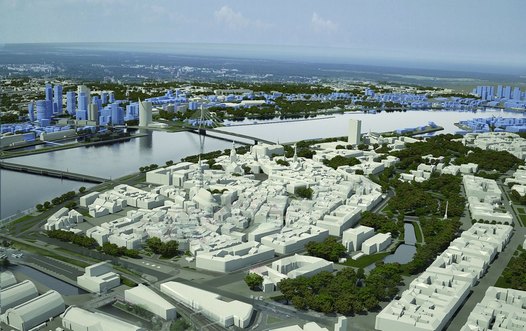
Model of Riga, the white areas are existing buildings while the light blue areas denote potential new developments. The white buildings in the foreground bordered by green areas highlight the 'old town'. On the other side of the river the light blue buildings indicate where, and to what extent, high-rise development can take place. The white tower on the the far side riverbank is the new Swedbank headquaters. Photo of model provided by the City of Riga.
In 1997 some 438.3 hectares of the historic centre of Riga were accepted onto the UNESCO World Heritage List. Surrounding the heritage site here is a further 1520 hectares of protected area or buffer zone, which includes part of the new high-rise development opposite the old town on the left bank of the River Daugava.
The beginning of the 21st century has seen many new challenges emerge for urban planners and politicians in Riga. The artificially created real estate market and the practice of speculation resulted in a euphoria of endless development and possibilities. Project developers required high and dense construction in almost all areas surrounding Riga city centre and actively used political lobbying to fulfil this desire. Urban planning started to resemble scheming and the liberal development plan adopted at the end of 2005 revealed several instances of spot zoning.
These densification and high-rise tendencies also affect the new centre of Riga in the areas adjoining the River Daugava, leading to a disjuncture between planning and scale. The planned group of high-rise buildings on the other side of the river directly opposite Old Riga, including a 121-metre tall office building constructed in 2004, resulted however in some disquiet and ultimately to further UNESCO involvement.
UNESCO threatened to exclude Riga from the endangered monuments list and in response Latvia promised to produce a silhouette concept for the left bank of the Daugava that would ensure a balanced approach and the preservation of the integrity of the complex monument that is the old centre of Riga.
Hard work and continual consultation between 2006 and 2009 resulted in a compromise which saw areas of high-rise buildings follow the main transport crossings over the Daugava thus retaining the pyramidal nature of Old Riga as well as the potential for compact urban development.
Discussion about the high-rise buildings located in the proximity of the historic centre of Riga created a remarkable level of public involvement leading even to the creation of a new non-governmental organisation, namely, the Movement for the Left Bank of the Daugava.
Public opinion tends to be poorly reasoned, emotional and favour financially lavish projects (such as the suggestion that the city of Riga purchases the area intended for high-rise development with a view to creating a city park there instead), yet the presence of strong public opinion certainly increased the level of responsibility of urban planners and project developers as well as the quality of spatial plans and projects.
The centre of Riga has always been "a violator of boundaries" particularly in respect of its surrounding medieval-origin fortification walls. In the mid-19th century the ramparts were pulled down, making it possible to create a green belt around the old town of Riga and a boulevard circle saturated in eclecticism.
In the late 19th century and early 20th century, development was both rapid and broad in scope. Riga was the main port of Tsarist Russia, starting in 1899 when the first Art Nouveau building was constructed the city centre was to acquire some five hundred of them by 1914. In only a few decades the population of Riga doubled reaching half a million people and the city centre area was spatially filled.
Construction in the centre of the capital city has always been and will remain a special focus of attention for politicians, architects and urban planners. In the years after the original Latvian state was founded in 1918, a period which saw the country acquire considerable wealth but lose its way in terms of democratic governance, the spatial environment of Riga was also transformed. By removing some of the medieval buildings in the centre of the old town Dome Square was created. Here a huge building for the Ministry of Finance was erected, and if it had not been for World War II, a town hall – a direct imitation of that in Stockholm - and a bulky building for the Post Office Savings Bank would have also been built at the expense of the city's medieval heritage.
Planning the development of Greater Riga the architect Eižens Laube in the 1920s and the architect Arnolds Lamze in 1932 intended to redirect development and architectural accents to the left bank of the Daugava. The reconstruction project for the centre of Riga in 1969, the spatial organisation scheme in 1980 (architect ĒE. Fogelis) and the Riga Development Plan for 1995 also intended to do the same.
Notwithstanding this, the spatial composition of the centre of Riga has been, and will remain, a compromise with some features of good taste created by the inconsistencies of the planners of different periods, Soviet ideology and the political and economic lobbyism of recent periods.
By Jānis Dripe, City Architect of Riga